What if we told you that you don’t need to sit, wait, and hope for customers to recommend your business to their network? With referral marketing, you can actively encourage existing customers and brand advocates to promote your products. In many ways, this has to be the ultimate in marketing practice.
After all, why entrust all of your marketing to a digital marketing agency to promote a product they likely have no personal connection with? This when you already have loyal customers who love your products.
Here’s how referral marketing can fuel business growth. From exclusive offers to software to referral marketing programs, find out what you need to leverage (and reward) customer loyalty.
- What Is Referral Marketing?
- Affiliate vs Referral Marketing: What’s the Difference?
- Why Is Referral Marketing Important?
- Different Referral Marketing Strategies
- Tips for Creating a Successful Referral Marketing Program
- Examples for Successful Referral Marketing Programs
- 1. NinjaPromo
- 2. Dropbox
- 3. Grover
- 4. Typeform
- How to Effectively Promote Your Referral Program?
- Key Takeaways
- Frequently Asked Questions
What Is Referral Marketing?
As the name suggests, referral marketing involves a customer referring a product or service they like to their network which can include friends, family, followers, and colleagues. It strongly connects to word-of-mouth marketing.
While word-of-mouth marketing is also considered to be a part of referral marketing, referral marketing is more deliberate and structured. Building a referral marketing program is an intentional choice.
Brands engaging in referral marketing encourage their customers to tell their network of friends about the company. They typically do this by providing some form of incentive to motivate customers to give referrals such as a:
- Discount
- Gift card
- Store credit
- Free product (or in the case of subscription models a free month or upgrade to the next tier)
Word-of-mouth marketing, on the other hand, is typically more spontaneous. It’s often initiated by happy customers, rather than from any deliberate attempt by the brand.
Let’s say you’re one of the 700 million people who use Dropbox. If a coworker complains about how he’s forever running out of storage space on his laptop, you could recommend Dropbox — the tool that you use (and love). This would be considered word of mouth.
Now, if you shared your custom Dropbox invite link with him and he created a new account. You both would’ve received extra free storage as part of Dropbox’s referral program. That’s referral marketing in practice.
It works because consumers trust the opinions of real people far more than they do those of the brands themselves. Plus, the potential of receiving a reward makes it worthwhile for customers.
Affiliate vs Referral Marketing: What’s the Difference?
As mentioned, referral marketing is very similar to word-of-mouth marketing. It’s also similar to affiliate marketing, with which it’s often confused.
With referral marketing, you turn to your existing customers. They then market your business and its offering to people whom they know. This is typically done by sharing their unique link in a direct message.
On the other hand, affiliate marketing broadens this network and can partner with third-party content creators like influencers or bloggers. As such, most of the audience to whom they recommend your product are strangers on more public platforms like a landing page or blog post instead of a one-to-one WhatsApp or email.
While both will receive some kind of reward, the type of reward also differs. With affiliate marketing, the incentive is typically a commission with some of the high-commission affiliate programs paying anything between 15% and 50% in commission.
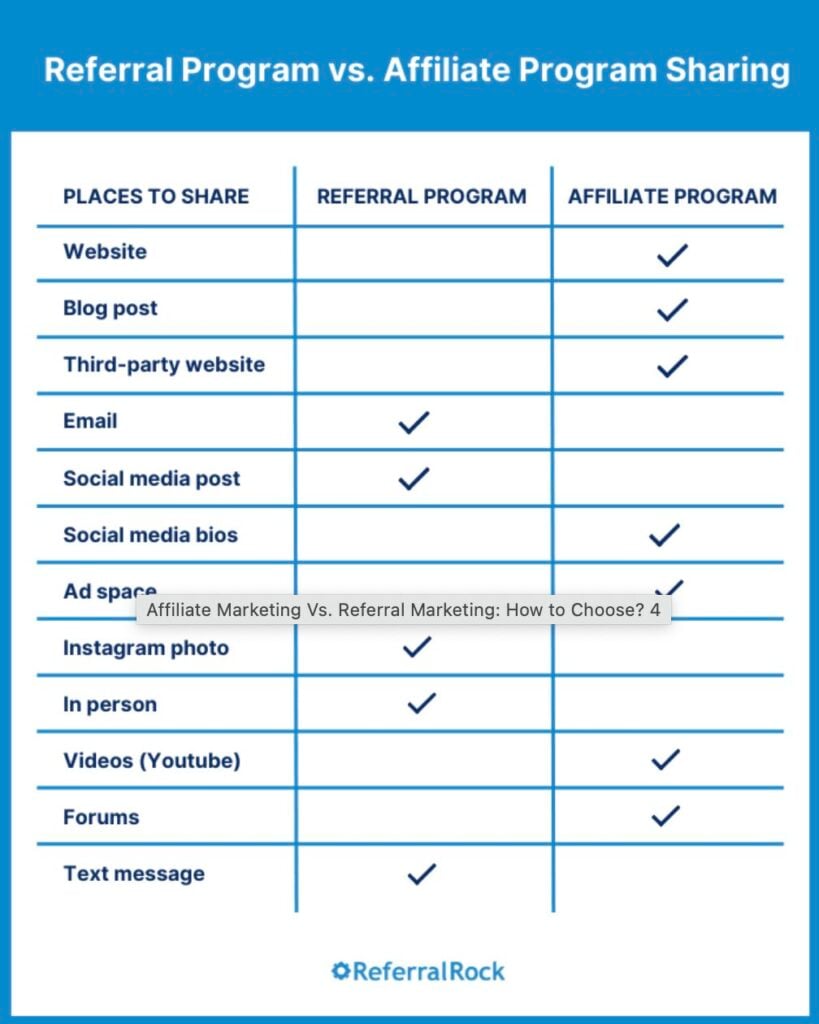
Source: referralrock.com
Why Is Referral Marketing Important?
The potential uptick in sales aside, a referral marketing program offers other pros like:
1. Builds trust
A survey completed among US adults in March 2024 reveals that nearly 89% of respondents listed friends and family as a trustworthy source for product recommendations. To put it into perspective, they’re more than double more likely to trust these acquaintances than an AI tool like ChatGPT.
Sure, you can rely on other human beings like expert reviewers to recommend your product. However, the same study found that only 74% of participants found them to be more trustworthy than their own network.
The point is that by asking existing happy customers to refer your product to their friends and family, you can win over customers who are less skeptical. As they already show a high degree of trust in you, you already have a deeper customer relationship from the start.
2. Referred customers are more valuable
Referred customers generally make more referrals, making them more valuable as customers. In fact, a research study published in the Journal of Marketing Research, has found that referred customers can make anything between 31% and 57% more referrals than non-referred customers.
Plus, if you remind them about how they discovered your brand in the first place - through a referral - they’re 21% more likely to refer you as well to their network.
Seeing that these customers are perceived as more trustworthy and know their network much better than you, the chances that these new customers will convert are higher too. It takes personalized marketing to a whole new level.
3. Cost-effective
With referral marketing, you require minimal upfront investment. The primary investment is usually the reward or incentive offered to the referrer.
What’s more, you have better control over the terms and conditions. For example, Dropbox, caps the free space that users can earn at 500 MB per referral for Dropbox Basic users. Also, they can’t earn more than 16 GB in total.
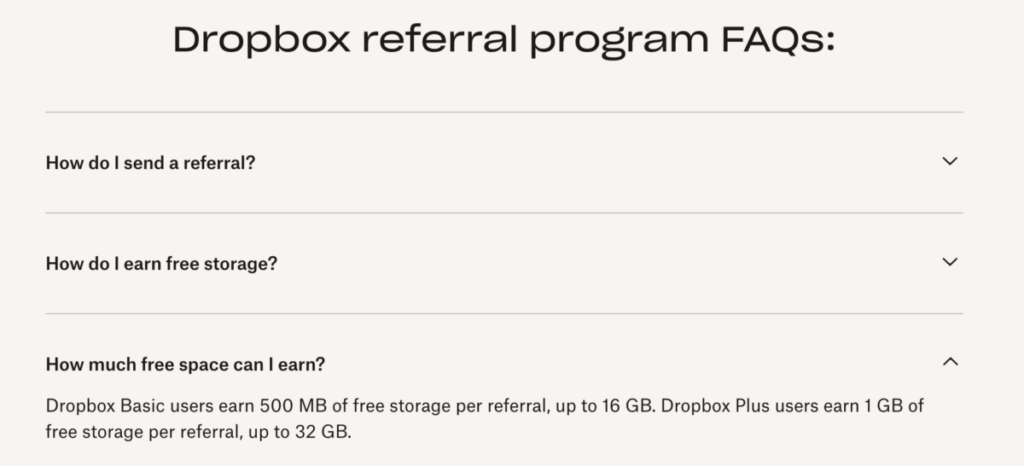
Different Referral Marketing Strategies
Brands wanting something more than informal customer reviews can take a more structured approach and use one (or more) of the following referral marketing strategies.
Using cash rewards
The appeal behind offering cash rewards is obvious. It’s an immediate reward that customers can spend anywhere.
An example of a business that uses cash incentives as part of their referral marketing strategy is PayPal. For every friend that sends or spends $5 within 30 days, both parties can earn up to 1,000 points which can be redeemed for $10.

When going this route, though, keep in mind that even $10 can add up. Let your profit margin guide you when you work out the amount.
Also, it’s a good idea to cap it at a specific amount they can earn in total. For example, in the case of PayPal, it’s limited to $100. Once they’ve referred 10 friends successfully, they can no longer participate in their referral program.
Creating a points system
This strategy is more complex and also lacks the element of instant gratification. That said, it can be more cost-effective for brands.
With this strategy, customers will earn a number of points per successful referral. These points can then be used to claim a free product or exclusive offers.
For example, you can set it up so each friend referred will earn them 50 points and once they have 250 points, they can claim their reward. As such, customers will have to land more than one customer before they can redeem their points. This makes it a great strategy if you want to encourage ongoing user engagement.
This strategy is also an attractive option for brands that already have a customer loyalty program. This way, you can tie it in with your existing points-based loyalty program.
Brooklinen’s referral marketing strategy is a good example of how you can use points and combine it with a loyalty program. While a friend referral will earn you the most points, it also rewards actions like writing a review which can generate social proof.

Aside from rewarding various types of activities with points, the points can also be redeemed in several ways. It can be used for free gifts, a discount off your next purchase, or donated to charity.
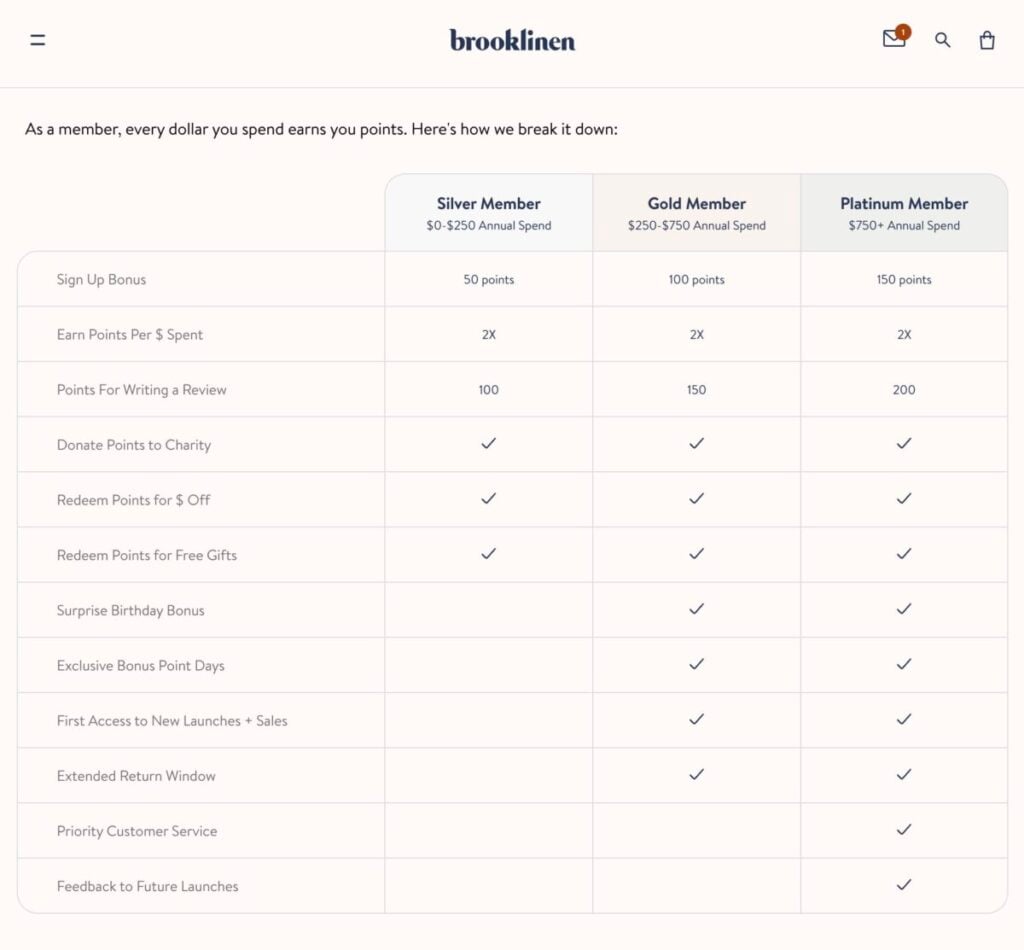
Giving your customers the option to donate their reward to charity is a great way to add an element of cause marketing. For example, with Brooklinen’s approach, customers can donate anything from $10 to $50 to one of the charities the brand supports.
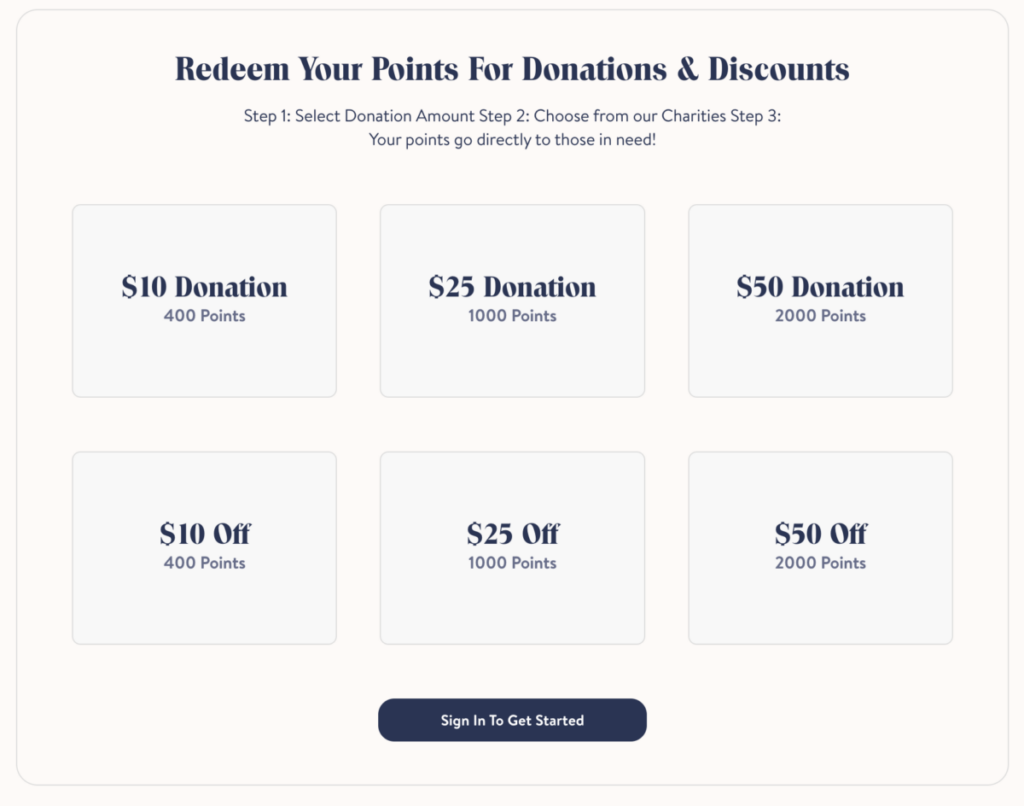
What’s more, the number of points you can earn are also linked to your current loyalty status. This way, high-value customers are rewarded. While Brooklinen chooses to reward all referrals with 1,000 points irrespective of their tier, you can easily reward big spenders with more points for this action.
Offering free products
Making a free product a reward can also be rewarding to businesses. It can double up as a way to introduce customers to new products.
While Brooklinen doesn’t strictly offer free products, they offer several products from which customers can choose when they’re ready to redeem their points acquired.

It can also encourage your referrers to create user-generated content (UGC). As it’s a physical product, it’s much easier to create a post sharing your freebie than to write about the points that were loaded onto your loyalty program.
Rewarding both parties
All in all, offering double-sided rewards is one of the best strategies for letting your referral marketing stick.
With this strategy, you’ll reward the referrer as well as the referee (aka the new customer you gained).
There are various ways that you can do that. You can, for example, give the referrer the option of sharing the incentive with the recruited customer.
Though, the most popular approach is two rewards from the outset — one specifically for the referrer and the other for the customer referred.
You can decide if you want the reward to be of equal value or if the one party’s reward (typically the new customer should be smaller).
For example, Bobbie, the first European-style organic infant formula that meets FDA standards, uses the same reward. Both will receive a free can to the value of $28.
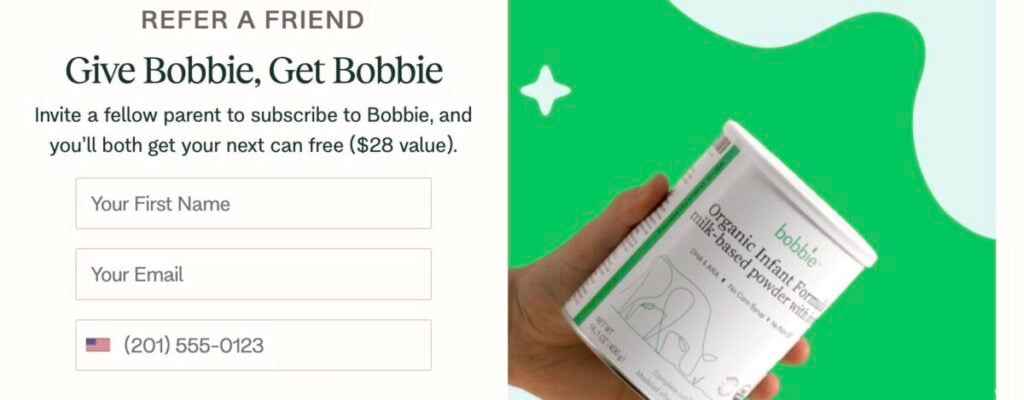
Linking the reward percentage to the product bought
If the value of your products differ quite significantly, you can adopt a strategy where the value of the reward is tied to the product that the customer buys. Brands like Dropbox and Casper use this strategy.
Here’s how Casper goes about referral marketing:
- If you refer a friend to buy one of their pillows, you’ll get $10.
- If your referred friend buys their first Casper mattress, you’ll receive a $75 Amazon gift card (the friend will also get 25% off their mattress order, doubling up as an example of how it can be turned into a double-sided offer).

Tips for Creating a Successful Referral Marketing Program
The goal of a referral marketing program is to generate warm leads. Here’s how to create a program that ends up running itself.
Keep it simple
Successful referral programs are simple to understand for all customers. People may like your product, but not enough to take half an hour out of their busy schedules to fill in forms and meet your administrative requirements.
Not only should it be easy to join, but the terms should also be described in a user-friendly tone. If it’s too complicated to understand, customers will find it easiest to ignore the referral program when they buy the product – even if they like the product and would happily recommend it.
For an example of how to keep it simple, take a look at how Dropbox approaches it. Via your Dropbox dashboard you can copy your invitation link which you can share in messages or social media posts.
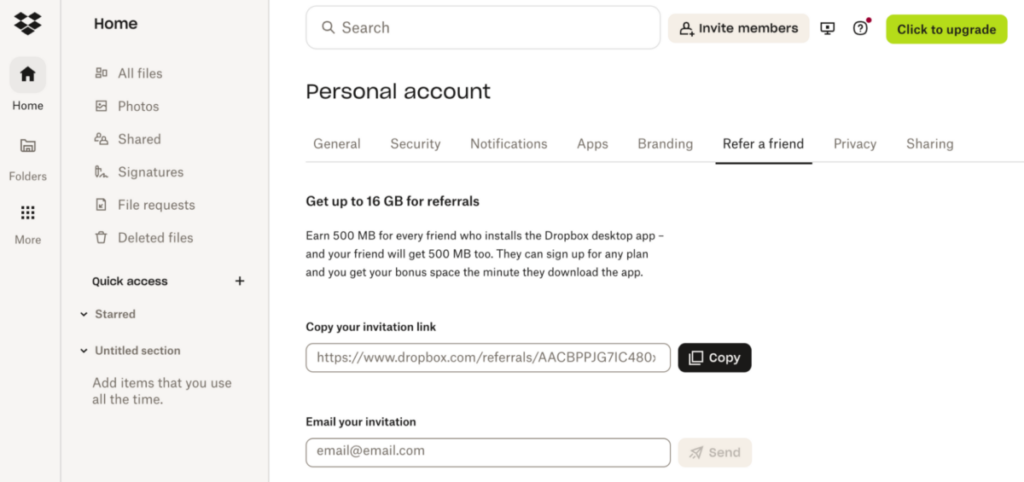
You can also email your invites to join directly via its dashboard. What’s more, if the friend already uses Dropbox, you’ll be notified.

It even generates the email. So, there’s nothing that the user must do other than enter the email address and click on Send.

Make your product experiences easily shareable
As well as making your referral programs simple to understand, make it easy for customers to share their experiences of using your product.
You can do this in many ways. For example, you can package your product in such a way that it makes for an interesting unboxing video. You can also create a distinct brand personality that encourages people to discuss your product.
Use a software to track referrals
For referral marketing to work, you’ll need to track which links generated which results. You want to reward your customers fairly.
To streamline and simplify this process, it’s best to use a referral software. For example, eCommerce businesses can check out tools like:
Improve your customer experience
No matter how good your referral program is, it will never succeed if you don’t give your customers a pleasant experience. You need to step up your customer service to a level where clients feel they can genuinely sing your praises.
People want to be heard and valued. If they identify a problem, there’s an expectation that you’ll solve it.
Ensure that your customer support staff is always responsive, authentic, and consistent when communicating with your customers.
Examples for Successful Referral Marketing Programs
Referral marketing can also be used by businesses that sell services like marketing agencies. For example, you can earn up to 10% of the initial offer or the subscription payment that your referral has generated for their agency. What’s more, you can earn recurring payments if the project turns into recurring business for their agency, an added incentive. The Dropbox referral marketing program has been mentioned a couple of times already. That’s because it’s such a great example and it’s still rated as one of the most successful ones and discussed case studies. In just 15 months, it has generated a growth of 3900% for the file-hosting service. Fast-forward over 10 years and it’s still running strongly. Referral Rock’s Referral Program Deep Dive series explains that it took a leaf from PayPal’s successful referral program. For PayPal, it made sense to use cash as a reward as their business is all about money transfers. So, for Dropbox it makes sense to give their customers more space. Here are two other reasons why it works: Grover, a leader in tech rentals that operates in the B2C eCommerce space, used Referral Rock to build their automated customer referral program. It’s another example of how you can reward both parties. When Grover subscribers refer a friend who ends up placing an order, they will receive €30 in cash. The friend will receive one month of rent on the house. It serves as a great example of how to promote your referral program and segment it. Referral banners are displayed on several key customer touch points including on their website’s home page, in the footer area, and via email messages. The result — over 5,000 customers registered in their first couple of months. They also went the extra mile to segment its customers based on language and created different programs for each language. Source: referralrock.com For an example of how SaaS businesses can structure their referral program, you can take a look at the route Typeform has taken. Instead of limiting it to a once-off cash reward, referrals can earn a monthly percentage. It strikes a good balance between instant gratification and delayed rewards. Referrals will earn $20 once their friend signs up for a paid plan. Then, they’ll earn 15% per month of the subscription amount. Needless to say, this can become expensive and the monthly rewards are capped at a total of $500. Though, you can refer as many people as you like. So, the most that you can earn is $520 per friend. This approach has helped them to grow steadily and increase their paid users by 10% each year. With the help of SaaSquatch’s flexible customization, they could also ensure the program matched their branding.1. NinjaPromo
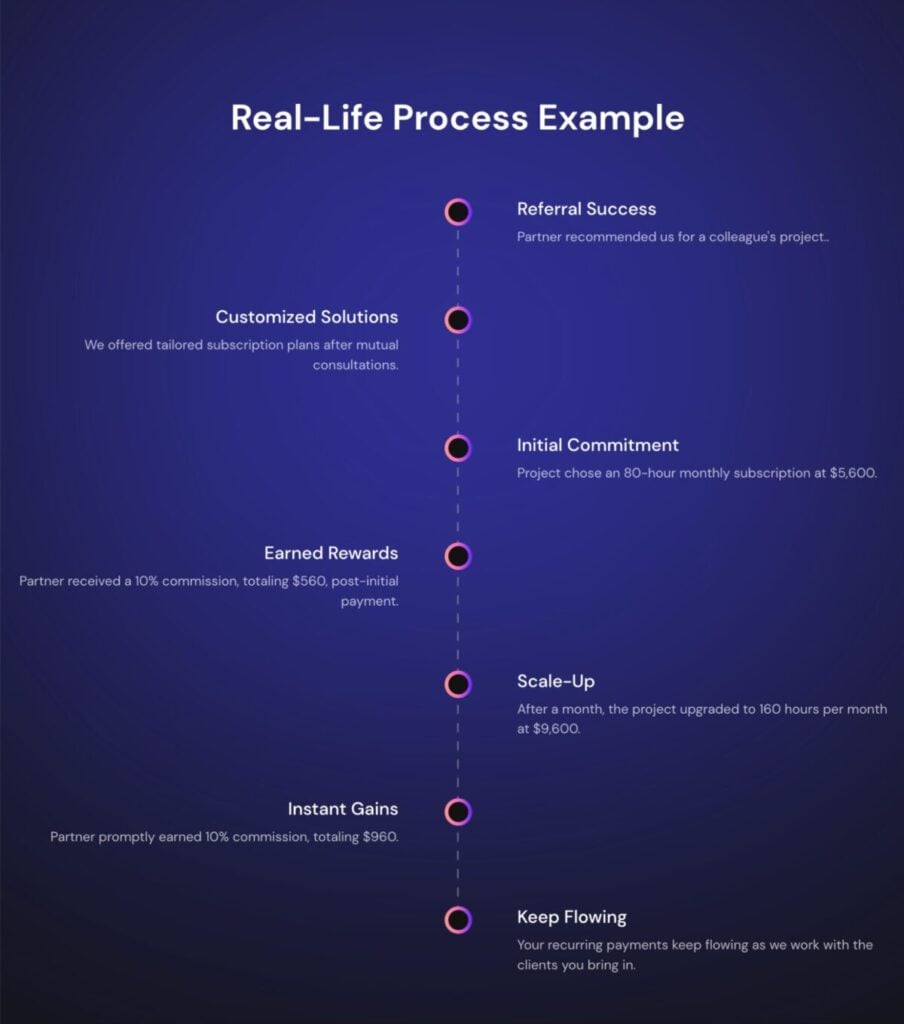
2. Dropbox
3. Grover
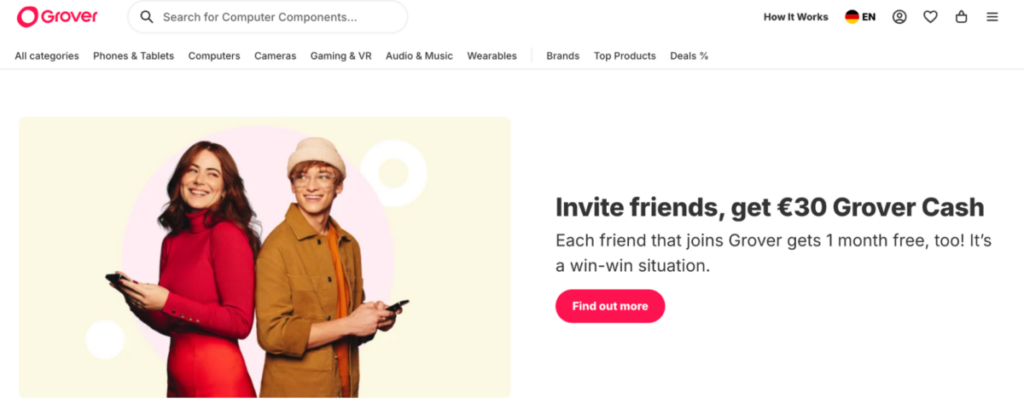
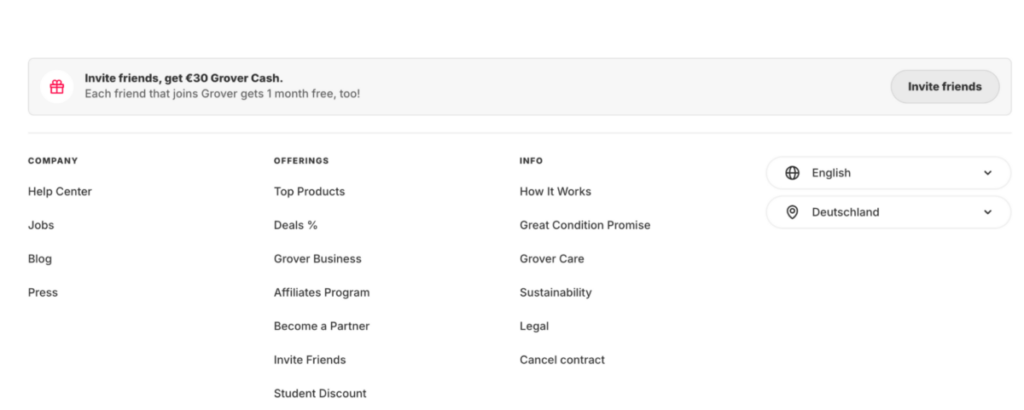
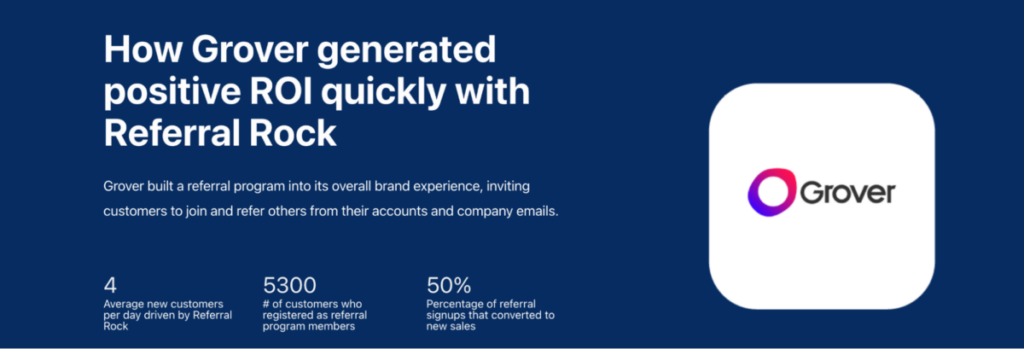
4. Typeform
How to Effectively Promote Your Referral Program?
If you’ve chosen to set up a referral program, you should probably give it a little nudge to improve the number of referrals people give you. There’s little point in having a referral scheme and not promote it to your potential customers. It’s supposed to incentivize a customer to take action, after all.
Ensure that you promote your referral program across all of your other marketing channels, much as you would your product itself.
Start by designing a page on your website dedicated to your referral program. Include all the details people need to know about joining your program.
Here’s how Fiverr has done that:
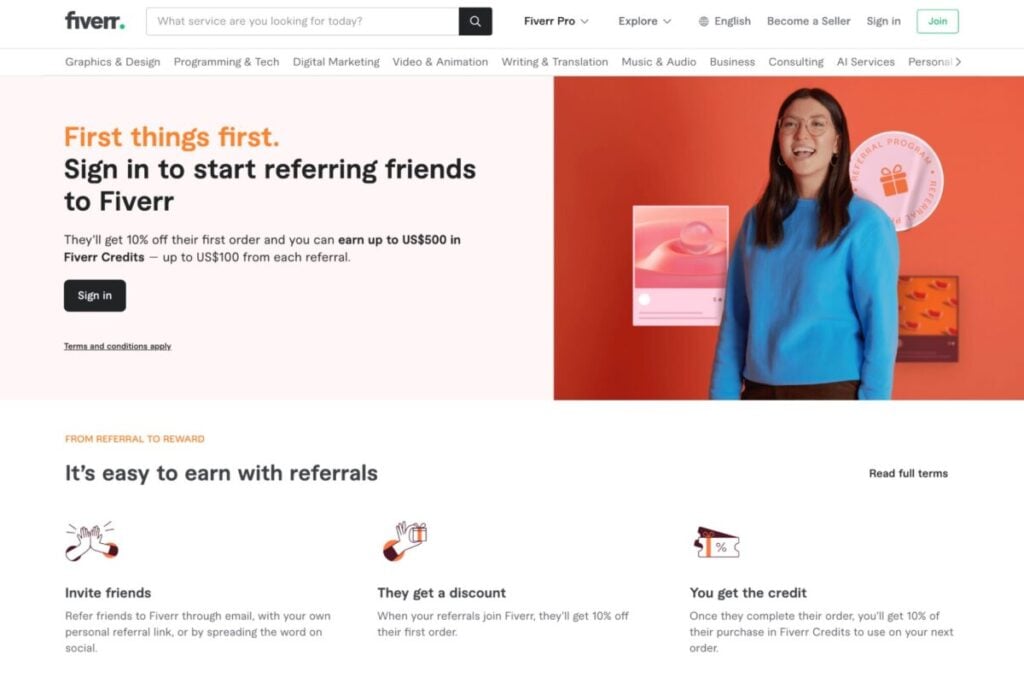
Source: fiverr.com
It explains the process, incentives, and includes a link to the Ts and Cs.
You can then also use emails, banners, and popups to spread the word. When using these tools, timing is crucial. Good times to ask include after a customer has taken following actions:
- Bought a product
- Left a good review
- Mentioned you in a positive light on social media
For example, Dropbox markets their referral program along with subscription plan options. This illustrates how you should essentially view your program as one of your products.

It's best to think of a referral program like an additional product in your product line – one where the brand pays the customer for a service, rather than vice versa. This can be quite different to everything else that a business sells. So, it's essential that every relevant person understands how it works.
This is particularly important for the brand’s employees. They need to be educated on how the referral program operates so that they can explain it to customers as easily as they can explain the benefits of the product range.
Key Takeaways
Many people think about giving positive referrals to their much-loved brands. Human nature is such that most don’t bother. Life moves on, and people get busy.
Though, if you provide some incentive to your customers for a positive referral, you’ll gain better results. You need to dangle a carrot. Just not an actual carrot, please.
The reason why you want to turn to your immediate customer network is aside from loving your brand already, their friends likely have relatively similar tastes.
Referral marketing also recognizes that people are inherently social. People naturally talk to their friends. They tell them both good experiences and bad. With referral marketing, you can ensure that the good experience is worth mentioning.
Frequently Asked Questions
Which types of businesses can use referral marketing?
There is a wide range of businesses and industries that engage in referral marketing including fashion, beauty, electronics, food, education, software and digital goods. It’s particularly useful for online businesses, presumably because people who buy goods online are more comfortable at sharing on social and other digital channels.
What are the benefits of referral marketing?
One of the most compelling reasons to implement referral marketing is trust. When a customer refers to your business, they vouch for your products or services, making new prospects more likely to convert too. The cost of acquiring new customers is also significantly lower. Referral programs not only attract new customers but also help retain existing ones. When customers feel valued and appreciated by being rewarded for their referrals, they’re more likely to stay loyal to your brand. This can create a cycle of repeat business.
What are the cons of referral marketing?
While it’s cost-effective, offering incentives can also become a financial burden. Constantly providing discounts, freebies, or monetary rewards can eat into your profit margins, particularly for small businesses operating on thin budgets. Referral marketing also limits your reach to the networks of your existing customers. While it can be effective, it may not be sufficient for achieving significant growth, especially if your current customer base is small.
Are referral and word-of-mouth marketing the same?
Word-of-mouth marketing forms part of referral marketing. However, referral marketing is more structured and deliberate. Word-of-mouth marketing is often initiated by happy customers and not the business itself. As such, customers do so without expecting a reward in return as is the case with referral marketing.
How can you encourage customers to recommend your brand?
Here are some ways you can encourage customers to recommend your brand to their network:
- Make your customers feel valued by offering exceptional customer service and personalizing the experience
- Offer high-quality products/services that exceed customer expectations
- Create a referral marketing program that rewards customers and make it easy to recommend your product using referral links and message templates
- Showcase customer testimonials, reviews, and success stories on your website
Which referral marketing tools can you use?
To help you with referral marketing, you can check out software like:
- Refersion
- Referral Factory
- CrewFire
- Friendbuy
- InviteReferrals
- Referral Rock
- Yotpo




